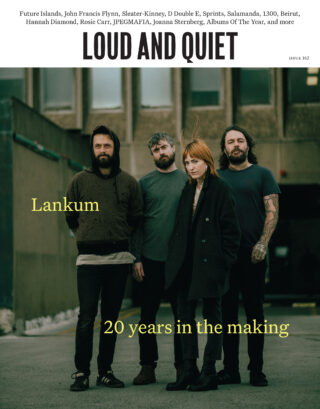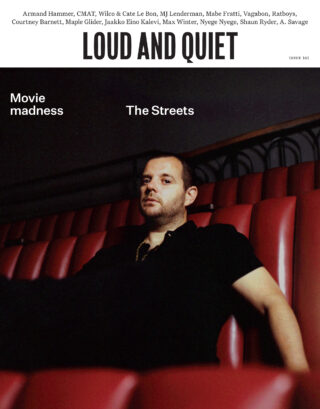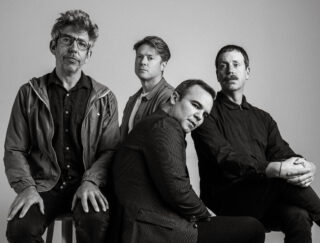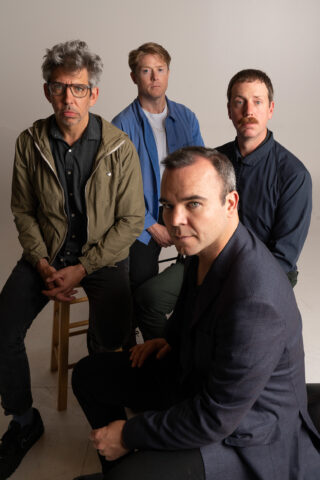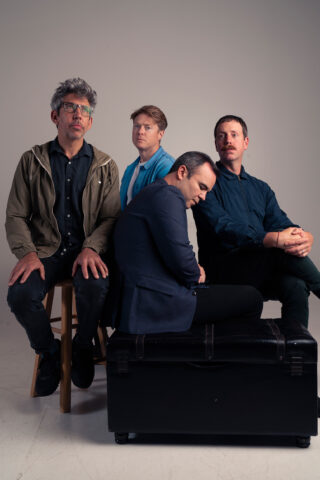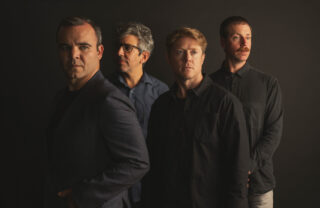Photography by Frank Hamilton
In February 2024 Future Islands will turn 18. That’s one hell of a birthday for a band that was never meant to stick around. “We’re almost becoming a legacy act,” singer Samuel T. Herring jokes. Settling into contemplation about what he’s just said, he continues, “I’m proud of that, but it’s not an easy thing.”
It’s surreal having one of the most long-running and well-respected bands in modern indie in front of you, but Future Islands are immediately affable and at ease – Herring chainsmokes throughout, alternating between a vape and a cigarette, lending our interview a laidback feel. This is their first conversation about their upcoming seventh album People Who Aren’t There Anymore, and they are more than willing to work through the album’s story and context; bassist William Cashion even thanks me for helping him to do that, as for him it’s often through press interviews, talking it through with his bandmates, that their albums become clearer for him.
The tale of Future Islands is almost apocryphal now, having been in the ether for so long, but it bears solidifying in the context of their upcoming album. After their first band Art Lord & the Self-Portraits broke up, founding members Herring, Cashion and keyboard player Gerrit Welmers were distraught. It was in the days of show trades – a band would put on a short headline tour in their part of the US so that a band from a different part of the country could support them. Then a few months later, they would swap so that each band could get some exposure in various areas of the States. Art Lord & the Self-Portraits had supported another band, The Texas Governor, before their breakup, and Cashion received an email from the other band asking how they were getting on with booking their leg of the show trade. Instead of admitting they didn’t have a band anymore, they cobbled together and formed Future Islands.
They never had any expectations of longevity. Herring explains, “Future Islands was a serendipitous name, but it made sense to me. It was perfect, like: we’re not going to be a band, we’re friends now, here in this one place, but soon we’re going to be spread out, doing our own things. It was an understanding.” But that understanding, thankfully, never solidified, and Future Islands kept on going.
Their focus as a band has morphed and matured over the years. Where at the beginning it was simply making sure that people heard them, now it’s more like making sure they’re still making stuff that’s worthy of being heard. Welmers says, “I was thinking recently about how, at some point, bands start putting out these records that are just like, not that good. [I’m] trying to crack the code of what happens when you’re turning 40 and you’re still in a band. Are you capable of still making interesting music?”
People Who Aren’t There Anymore answers this question with a definite, resounding yes. Coated in the iconic Future Islands soundscape (glimmering synth chords, twanging prominent basslines and Herring’s versatile yet distinctive vocal timbre, scratchy and tender all at once), it paints a protracted snapshot of a longer period in the band’s lives. Some songs were written as early as July 2020, with the most recent ones being written up until mid-2022; as a result, the album is neatly “broken in half”, as Herring puts it. “A little bit more than half of the record was written when I was still in a relationship, and then the second half was quickly spewed out on the other side of that relationship.” If their previous album As Long As You Are was about finding peace in maturity, People Who Aren’t There Anymore is about the bitter reality of people falling out of your life as you get older.
The band agrees that the process of writing this new album was a continuation of the one that they had begun for As Long As You Are: writing more consistently, taking the time to write and record as and when they wanted. An altogether more comfortable process than the one for their album The Far Field which followed hot on the heels of their breakout fourth album Singles. They played over 300 shows in one year touring that album, then felt that they had to record another one just to keep the train on the tracks. Herring reiterates at several points throughout our interview that they have shifted to seeing the process of album cycles as less distinct than previously; each album is a continuation of the other, in conversation with each other, to draw a picture of a band evolving over time. Think less about eras, more about a growing timeline.

